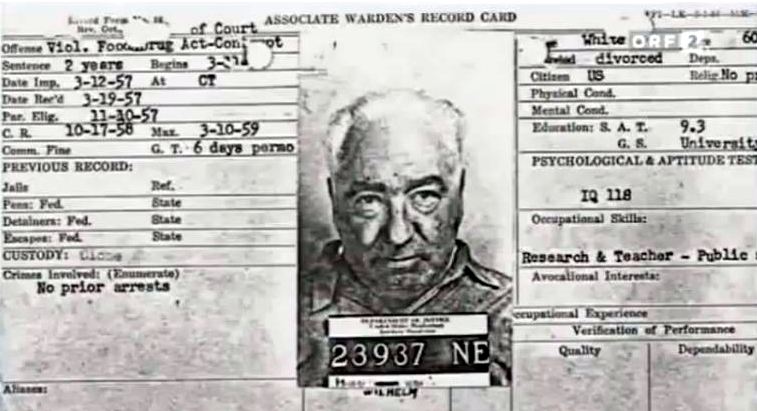Conner Habib’s series The Sex Radicals will be appearing regularly this summer on Reality Sandwich.
“Civilization has not yet begun.” –Wilhelm Reich (1897 – 1957)
To view sexologist and psychoanalyst Wilhelm Reich as our culture views him, move through his life backwards. When he’s remembered today, he’s summed up and dismissed by his sad ending. He’s thought of mostly as a madman, dying alone in prison, a fraud, discredited by the government.
To view his life as one of his supporters, move through it from the beginning of his career to the end; he worked tirelessly to help others, and was eventually driven mad by the mad world he lived in.
To really understand Reich, the narrative shouldn’t be backwards/forwards. We should look instead at his ideas — whether they are true or false — and the possibilities they create for us. Instead of taking a linear approach, we can take a sexual one. Pain and pleasure intertwined. Thought and action. Tension and release. View Wilhelm Reich as a paradox: a man who revealed a new, loving world to us in an angry language we still can’t understand, a man whose work was officially dismissed as ludicrous but also taken seriously enough to merit governmental seizure and destruction when all his journals, books, and papers were burned by the FDA.
Here’s a lengthy quote from Reich’s book, The Murder of Christ: The Emotional Plague of Mankind, which, complete with shouting capital letters, shows him in all his glory: a profoundly clear thinker, ranting in a crazy tone, shocking us with truth and confusion all at once.
“It IS possible to get out of a trap. However, in order to break out of a prison, one first must confess to being in a prison. The trap is man’s emotional structure, his character structure. There is little use in devising systems of thought about the nature of the trap if the only thing to do in order to get out of the trap is to know the trap and to find the exit. Everything else is utterly useless…
The first thing to do is to find the exit out of the trap.
The nature of the trap has no interest whatsoever beyond this one crucial point: WHERE IS THE EXIT OUT OF THE TRAP?
One can decorate a trap to make life more comfortable in it.
This is done by the Michelangelos and the Shakespeares and the Goethes. One can invent makeshift contraptions to secure longer life in the trap. This is done by the great scientists and physicians, the Meyers and the Pasteurs and the Flemings. One can devise great art in healing broken bones when one falls into the trap.
The crucial point still is and remains: to find the exit out of the trap…
The exit remains hidden. It is the greatest riddle of all. The most ridiculous as well as tragic thing is this:
THE EXIT IS CLEARLY VISIBLE TO ALL TRAPPED IN THE HOLE. YET NOBODY SEEMS TO SEE IT. EVERYBODY KNOWS WHERE THE EXIT IS. YET NOBODY SEEMS TO MAKE A MOVE TOWARD IT. MORE: WHOEVER MOVES TOWARD THE EXIT, OR WHOEVER POINTS TOWARD IT IS DECLARED CRAZY OR A CRIMINAL OR A SINNER TO BURN IN HELL.
It turns out that the trouble is not with the trap or even with finding the exit. The trouble is WITHIN THE TRAPPED ONES.
All this is, seen from outside the trap, incomprehensible to a simple mind. It is even somehow insane. Why don’t they see and move toward the clearly visible exit? As soon as they get close to the exit they start screaming and run away from it. As soon as anyone among them tries to get out, they kill him. Only a very few slip out of the trap in the dark night when everybody is asleep.”
Reich was an Austrian-born student of Sigmund Freud’s; he was a promising figure in psychoanalysis who eventually departed from the circles that praised him. Contrary to the common condemnation of psychoanalysis for its preoccupation with sex, Reich’s idea was that it didn’t focus on sex enough.
For Reich sex was it.
He allowed the mysteries of sexuality and sexual drives to lead him to a deep and frantic understanding of our culture. It’s an understanding that shakes you away as you follow, and I can’t claim to understand it fully. To read Reich is to allow yourself to live in inspiration rather than total clarity. So here are four of his basic concepts, which intertwine and grow out of one another:
Character analysis, character armor, orgastic potency, and orgone energy.
With his concept of character analysis, Reich worked to examine what people’s resistances to health and happiness were. Why were they avoiding wholeness and integration? How did they excuse themselves into surviving — knowingly or unknowingly — in suffering? Unlike analysts before him, Reich sought to be more precise and less moralizing. What are the moments of your life, he wanted to know, that have led to your characteristic defensive behaviors? We have a torrent of emotions within us awaiting expression, we are shamed into silence by our families, our cultures, our partners. The chilling effect of these outside forces turns our emotions into “frozen history.”
If this aspect of character analysis seems common, Reich’s theory of character armor and the corresponding concept of orgastic potency are still waiting to be embraced. Character armor was premised on the idea that the body is a sort of material reflection of the emotional state. Or to use Simone de Beauvoir’s words, “The body isn’t a thing, it’s a situation; it’s our grasp on the world and our sketch of our project.” Whenever we have a defensive emotional gesture, it becomes bound up in our situations, our projects, our bodies, stuck like a choke. For instance, people with anxiety issues often have shallow breathing patterns or tense jaws. These knots in the body stop energetic flow and cause all sorts of health and mood problems that might seem unrelated to the initial characteristic defense.
If you’re flinching at the word “energetic,” you’ll want to know that Reich tried to flesh out what that meant. As with much of his work, he both succeeded and failed. His concept of “energy” was sexual energy, a refined version of the psychoanalytic idea of “libido.” He believed sexual excitation underlies many of our motivations, but also that it is a continuation of the creation of life itself. The same exuberant force that leads to life is what makes us happy and healthy. Sex creates us, and our lives and motivations are living praise of that creative act; our painful behavior is a contracted, angry refusal to acknowledge our sexual being-ness.
Reich understood culture as a giant sexual expression gagging on tangles of repression. The stored up sexual energy and frustration of a culture becomes oppressive. The Nazis (whom Reich later fled), for example, opposed birth control, abortion, contraception, and homosexuality. They were totally sexually repressed. One of Reich’s revolutionary stances was to support sexual freedom, even if he was against a particular sexual practice. It was a typically Reichian paradox. For instance, he wasn’t thoughtful enough to allow homosexuality to be “healthy,” but he did fight against anti-gay stigmatization and legislation.
The taboo, he knew, was always more dangerous than the act.
Modern-day Reichians have carried on his work to explain how cultures co-create our character armor. Class and gender inequality as well as adverse environmental conditions create a positive feedback loop. Sexual repression occurs as a result of poverty, which creates armored behavior, which creates more repression, and so on. And certain environmental factors echo familial ones. “…the emotional responses of a child to famine and starvation are similar to those stemming from maternal rejection or isolation — rearing factors which are known to have powerful disturbing effects upon later adult behavior,” writes neo-Reichian researcher James Dameo.
Reich was invested in individual responsibility, but was also a true pioneer in pointing out that it’s not you that’s fucked up, it’s culture.
Individuals are not merely selves — they are conglomerates of cultural pulses and counterpulses. Or, as biologist and symbiosis expert Lynn Margulis once put it, “Identity is not an object; it is a process with addresses for all the different directions and dimensions in which it moves…”
How to dissolve the character armor? Sex.
To free up sexual excitation and dissolve character armor, one must be able to immerse him/herself in sex, and to have a liberating orgasm. The orgasm was of primary importance to Reich, and “orgastic potency” was how fully you experienced it. The orgasm was the event of release; all the stored up excitation left the body, resulting in total relaxation and harmony. In essence, orgastic potency measures a person’s ability to surrender, relax, and release neuroses and psychoses.
Before we start shooting our celebratory confetti into the air, Reich was specific about the sorts of orgasm you could have. Not all orgasms were equal. You had to be thoughtful about your total immersion. People who weren’t, as well as people who were merely intelligent about sex without really engaging in deep thought or practice of it, were, for Wilhelm Reich, merely sexually sophisticated rather than sexually liberated. It’s a dichotomy that should haunt every sex-positive person to the core until they come to terms with it. That doesn’t mean accepting Reich’s terms for who is sophisticated versus liberated; take those or leave them. But it’s true that standard cultural sex education and good feelings about sex aren’t what separate the sex radicals from the openly horny. Sexual liberation of ourselves and culture is a deep and unending work.
Reich developed a few methods to release stuck energy and increase orgastic potency. Most prominent was vegetotherapy. A patient lies on a table and breathes deeply and rhythmically to build up excitation and heighten emotion. The Reichian therapist sits close by, speaking gently. Relax, relax, release your muscles. Often, a scream or a flood of tears erupts from the patient.
Many popular forms of alternative medicine, such as the Alexander Technique, bioenergetics, and Rolfing are new versions of vegetotherapy, seeking to thaw frozen histories. But if these techniques are known, their ties to Reich are often secret, severed, or ignored.
Then Reich discovered cosmic energy. And that’s when the feds came.
Reich’s idea of libidinous sexual energy began to morph, through the lens of his theories and studies, into a stranger principle of “orgone” energy. Orgone energy was “a subtle biophysical energy which permeates all living things.” For Reich, orgone was the truth behind what people called God, a scientific principle to explain away mysticism. It was free-flowing and, because it was free, it could be used to help people undo character armor. To this end, he created orgone “accumulators,” which would gather the energy and allow people who sat inside the boxes to absorb the benefits. He also turned his accumulator inside out into a “cloudbuster,” a sort of rainmaking device which helped disperse atmospheric orgone energy knots.
People were sick. Culture was sick. Even the sky was sick. At the center, Wilhelm Reich was trying to heal everyone. In the process, he absorbed their illnesses.
Most of Reich’s later work revolved around orgone energy, and much of it yielded provocative data. But Reich’s theories were too intangible and unintelligible. Orgone energy was never clearly defined enough to communicate his research to many others, and unfortunately, Reich would publicly vent the frustration of being misunderstood again and again, isolating potential allies. When Albert Einstein visited Reich, for example, and stood in an accumulator, he noted that there was a temperature change in the box, but believed it could have been just a run-of-the-mill temperature gradient. Many others had experienced this temperature change (including in boxes other than the ones Reich made and ones manufactured today), and Reich created controls against such normal gradients. But rather than absorb Einstein’s report as data, he repeatedly wrote to Einstein pressuring him to reassess his position. When Einstein didn’t respond, Reich called it a conspiracy and published a book about it.
Reich wanted to help free us from a history of repressions, and by helping us, finally begin civilization. But what gets frozen in a man who tries to unfreeze history, and fails?
We can still take up his lesson: Sex runs through culture like a hidden line of power, and where we don’t release it, where we don’t help each other come to our senses, we hurt ourselves and everyone else.
However we look at the paradoxical figure of Wilhelm Reich, we’re unsettled.
Maybe Reich was so crazy that he created an entire theoretical world out of himself, a world now available to us for to think about, mull over, fear, delight in. Or maybe he was so sane that he showed us we’re all crazy.
Kate Bush’s song, “Cloudbusting,” calls up Reich’s final days, from the viewpoint of his son.
On top of the world
Looking over the edge
You could see them coming
You looked too small
In their big black car
To be a threat to the men in power
Reich was a powerless threat to everyone in power.
He’s still a threat. The more we forget him, the more potent discovering him again becomes.
Next up: Impossible Pleasures: Charles Fourier’s Queer Theories
Sources
Boadella, David. Wilhelm Reich: The Evolution of His Work. London. Arkana., 1985.
DeMeo, James. Saharasia: The 4000 BCE Origins of Child Abuse, Sex-Repression,
Warfare and Social Violence, In the Deserts of the Old World. Ashland, OR:Natural Energy Works, 2011.
Reich, Wilhelm. The Mass Psychology of Fascism. New York. Farrar, Straus and Giroux, 1980.
Reich, Wilhelm. The Murder of Christ: The Emotional Plague of Mankind. New York. Farrar, Straus and Giroux, 1953.
Wilson, Colin. The Quest for Wilhelm Reich. New York, Anchor, 1981.











